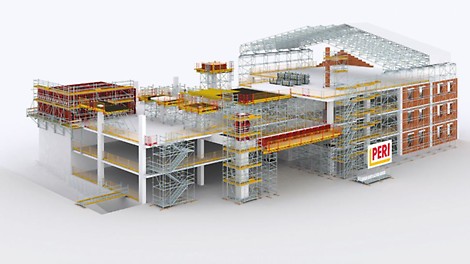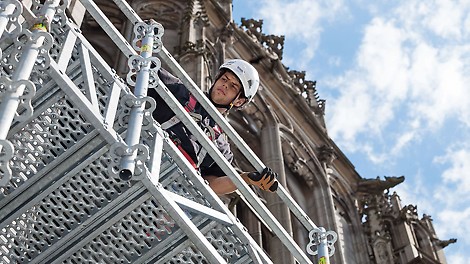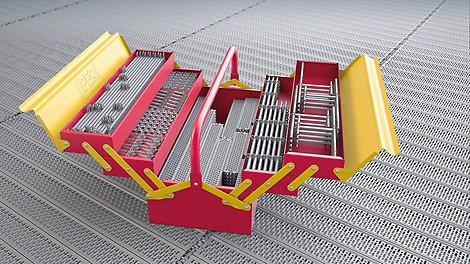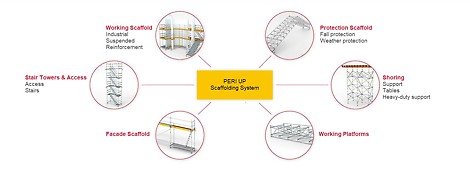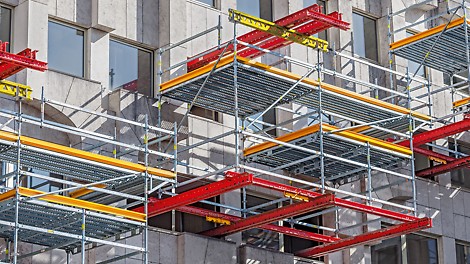PERI contact person
Would you like to find out more about PERI’s scaffolding technology? Then contact us.
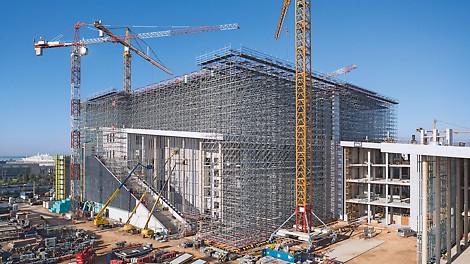
Scaffolding and shoring are common place on almost any construction site, regardless of buildings, infrastructure or industrial structures being built, maintained or demolished. Whilst the function of the scaffolding and shoring systems provide are varied, they can be broadly categorised into the following:
Despite the long-standing use of scaffolding in construction, dating back to traditional materials such as bamboo or timber, they have generally not evolved sufficiently to meet modern construction demands. The core components of a scaffold remain basic, and the evolution of the practice still has two major challenges:
Against this background, PERI has developed a new type of system scaffold with the central concept of a modular scaffolding kit. Built-in safety, highly efficient, minimum parts and suitable for all scaffolding applications.
As scaffolding is not only responsible to support the calculated loads of structures, but also provide a safe working space for workers at height, it is manufactured, designed and sold to stringent standards.
Our origins as a company and manufacturer in Germany, have resulted in products being designed and made to the highest standards. This means regardless of where in the world you source and use PERI equipment, you can rely on the quality, durability and long-lasting performance time after time.
The proof of the usability and performance of the product ensures that so long as it is used as per the design sequence and/or in compliance with the assembly rules and instructions for use, the PERI UP scaffolding system will perform to even the most demanding requirements.
In comparison to the original wooden materials used for scaffolding older building history, iron and steel quickly became established in the industrial age. In the 1920s, the first tubular steel coupling frames were used in the USA, which allowed a high degree of freedom in their geometric structure. In the 1930s they also came to Europe and were quickly successful. They combined a large number of system-independent components, primarily pipes with a defined diameter and wall thickness, connected via various types of couplings to form a load-bearing structure.
Though geometric flexibility and high load capacity could be achieved with the correct design, the disadvantage of this approach included high weight of components and great effort during installation and dismantling. In addition, more time is required for completion, approval and control due to the many parts and manual nature of their handling.
In the 1950s and 1960s, the development and use of system scaffold frames began, which essentially combined varying degrees of the components in to pre-assembled parts. The driving factor of this new phase in scaffolding development was to improve output (area and volume) of scaffolding construction in shorter working hours.
In Europe during this time, largescale developments of housing, commercial buildings, municipal structures and infrastructure, demanded more efficient and productive ways of working. Part of this process also required a more standardised approach to construction equipment manufacture and use, and the standardisation of processes and standards.
True system scaffolding evolved from the initial frame systems to provide a modern and efficient product. Standard construction tasks can be mapped more easily and therefore planned more quickly, the times for assembly and disassembly are significantly reduced and with the decreasing number of individual parts and connections square meter of structures, the safety is also increased.
First came frame scaffolding, then modular scaffolding usually summarised under the general term of system scaffolding. The two types of scaffolding combine the essential components i.e. welded parts fully equipped with connecting elements.
Modular scaffolding is characterised by attached connection nodes for the mechanically strong connection of various components to the vertical support structures (standards). Other components include horizontal bars and diagonals with the corresponding connecting parts for the nodes (ledgers and braces). The arrangement, design and function of the nodes is manufacturer-specific. The grid of nodes allows different field lengths, widths and heights.
All types of system scaffolding are generally suitable as façade scaffolding. In particular, modular scaffolding, when constructed in a small-scale grid, can be better adapted to irregular structures than frame scaffolding, despite prefabricated components.
The demands on the performance of scaffolding have increased continuously since the introduction of system scaffolding.
This was the trigger for PERI to invest in the development and production of work and protective scaffolding in 1996 - to find new solutions and help solve the challenges of modern construction for our customers.
The modular principle that has been successfully developed in formwork and shoring construction is also be the basis for our scaffolding concept. In addition to the general requirements for stability, load-bearing capacity and safety during assembly, conversion and dismantling, PERI UP was also developed to ensure:
The PERI UP scaffolding system requires the same core set of components regardless of use: stair towers, working platforms, protection systems, façade, reinforcement configurations and shoring all from one system. Based around the Rosett node, this is the core element for connecting vertical standards and horiztonal ledgers.
Another major advantage of the metric grid system lies in compatibility with the components VARIOKIT engineering kit, which is used for heavy-duty construction. Depending on the requirements in either building, infrastructure or industrial construction the core components of the two modular system systems PERI UP and VARIOKIT can also be combined with each other. These combinations allow flexible, safe and quick implementation of construction with limited load transfer into the ground and into the structure.
The high quality manufacturing processes combined with minimal number of parts provides further advantages. The multiple use of the same system components increases their material utilisation, which leads to reduced investment and assembly costs. PERI UP's high share of common parts also results in less storage and transport space required, reduced maintenance costs and fewer repairs.
At the heart of the PERI UP system are self-securing components to provide built-in safety. The rosette shape of the connector is designed to self-secure during assembly depending on the parts being connected.
Eight connections are possible directly at the node, and additional hole openings in the horizontal bars provide four more connection options near the node. The hook-shaped latch connection can be easily and accurately inserted into the rosette, even from a safe distance. The safety wedge falls into the recess due to its own weight and locks automatically (Gravity Lock). This prevents accidental loosening for example due to impact on the underside of the latch, and enables safe one-man assembly of individual components.
The scaffolding deck is a fundamental component of any scaffolding structure. Our use of the metric grid system has many benefits here. The covering grid of the PERI UP scaffolding construction kit is based on the basic module 25 cm (with the facade application also having a 33cm option available). Thanks to this consistent metric grid, the most favourable laying direction can always be chosen so that safe and gap-free work surfaces can be created. This means that even tight spaces with difficult geometries can be safely and fully surrounded, making work on the platform safe for the workers, and anyone below protected from falling materials.
For façade applications, two elements of the PERI UP scaffolding kit can be utilised - both PERI UP Flex, or the Easy façade application. Both follow the concepts of improving safety by utilising lightweight components to protect the workers and reduce overall loads, as well as safety at height features.
The PERI UP Easy façade scaffolding is always assembled, converted and dismantled from a safe position. Guardrail components can be hung and locked from below before the newly created scaffolding level is created. Therefore at no point do workers have to construct the system with an open edge and potential to fall from height.
The planning and calculation of scaffolding structures, particularly in infrastructure construction and in technically demanding projects, has now become a complex task. This is not just about the necessary static calculations outside of applications in standard execution. Examples of this are large infrastructure structures in road construction, but also power plants, shipyards or complex architectural designs typically seen for museums, concert halls and opera houses.
The requirements for scaffolding technology on site ranges producing a mirror replica of the structure with sufficient work surface area for the staff to conduct operations, and storage options for equipment and materials, up to the planning of a conversion of the scaffolding structure during ongoing operations.
To meet the technical and operational requirements needed, our network of depots and engineers supports scaffolding customers directly to overcome the challenges of their projects. Utilising experience from around the world of projects ranging from simple to the most complex possible, we can provide a fast, safe and efficient solution.
To provide further technical capability, our digital engineering offer includes support for CAD programs for 2D and 3D planning to web-based configurators to determine the characteristic values for support towers and shoring. We also provide database-supported 5D planning using the BIM methodology. Stored process data can already be used for simulations in order to use detailed structural visualisations to identify problems that go beyond static calculations, e.g. restricted access during construction.
How different the spectacular new building project Edificio Ágorain in Spain is compared to the Ruhleben waste-to-energy plant in Berlin with its nested building structure. In order for successful construction to take place, large scaffolding structures were planned, created and built for working platforms, as load-bearing and shoring structures for concrete formwork, as safe access routes and for weather protection.
Would you like to find out more about PERI’s scaffolding technology? Then contact us.
